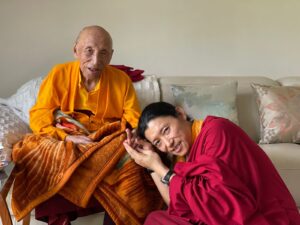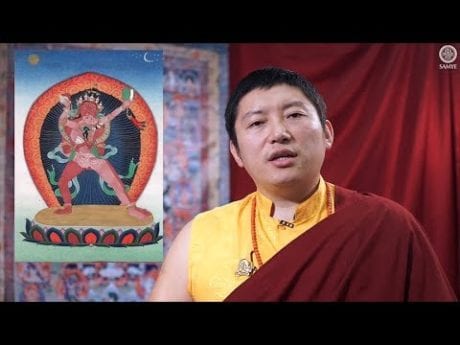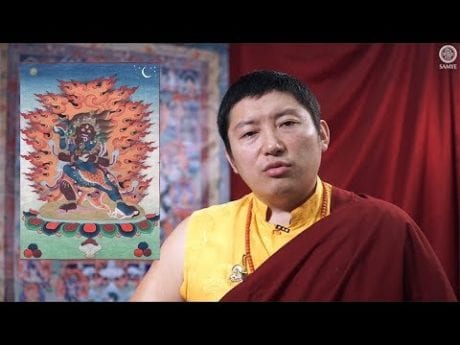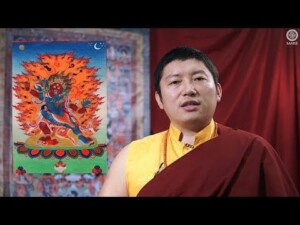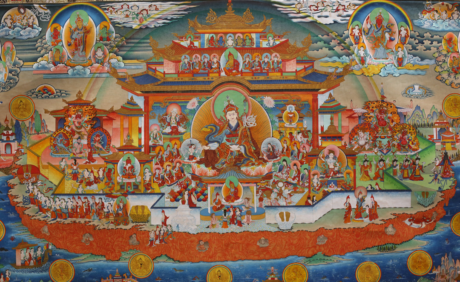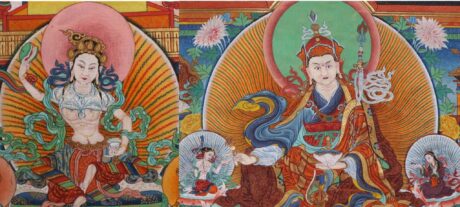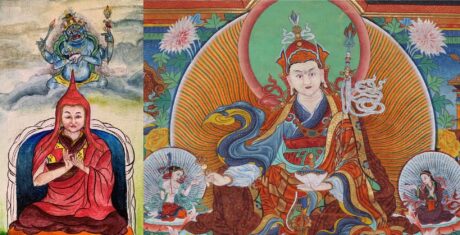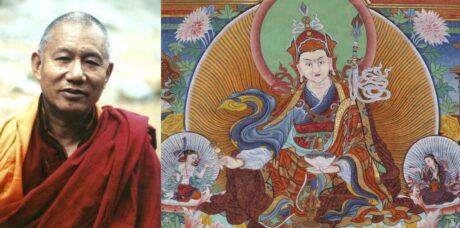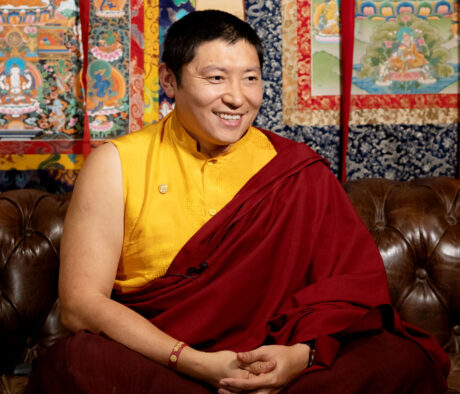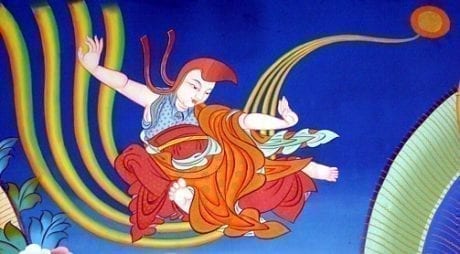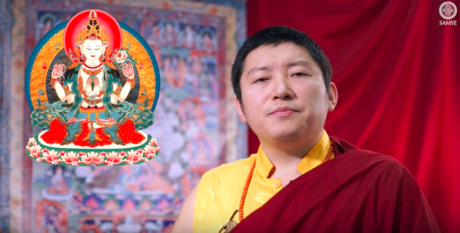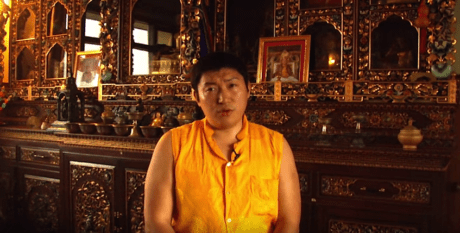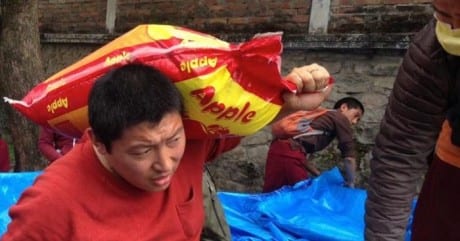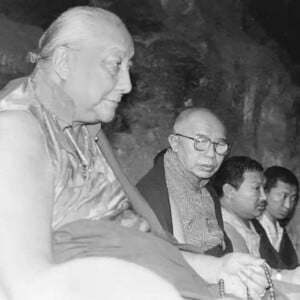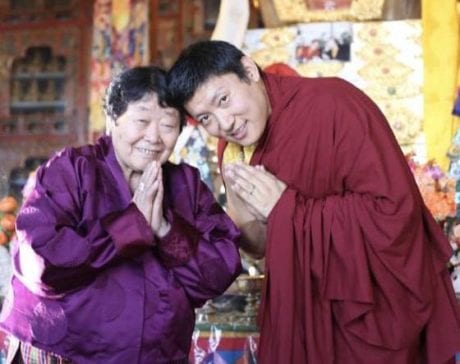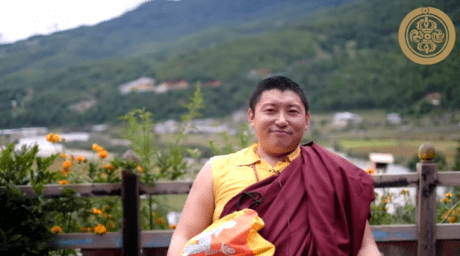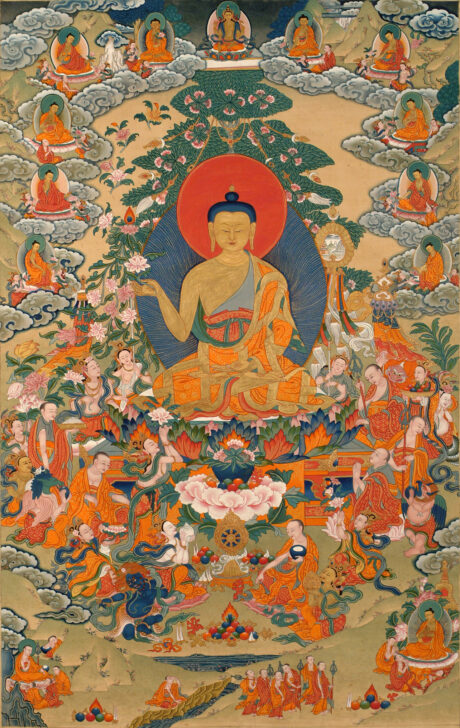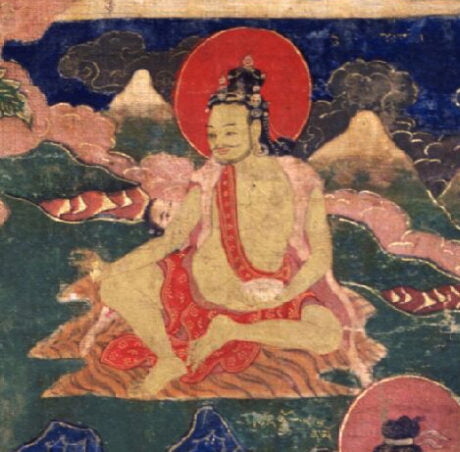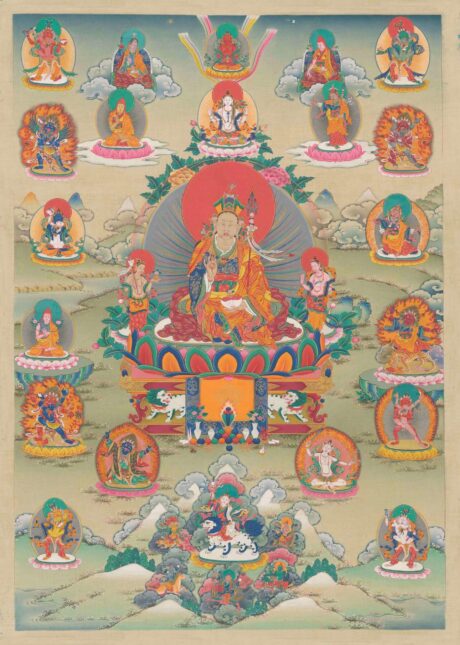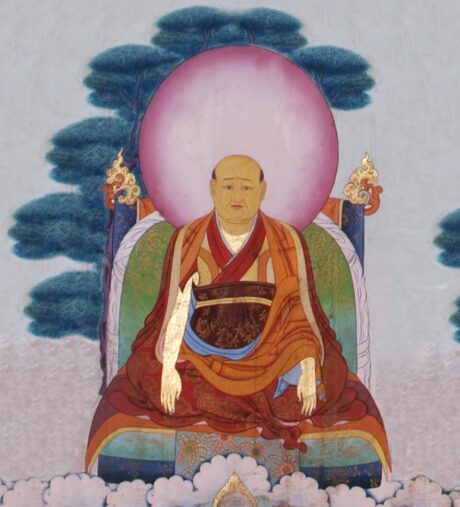Guru Rinpoche Day Teachings
The Sacred Tenth Lunar Day
Latest Teaching
Who Is Guru Rinpoche?
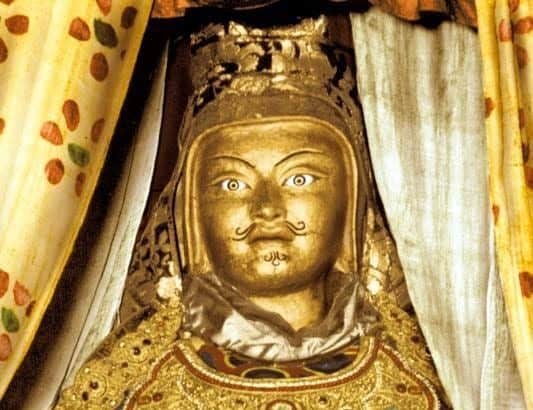
Guru Rinpoche (Precious Master) is also known as Padmasambhava (Skt.), or Padmākara. Tibetans consider him the founder of Tibetan Buddhism. For this reason, he is often referred to as the “second Buddha”. Guru Rinpoche was instrumental in bringing the Vajrayāna teachings to Tibet, arriving in the Iron Tiger year of 810 CE. In Tibet, he is famed for taming the local spirits by converting them to be protectors of the Dharma.
We often refer to Guru Rinpoche as Pemajungné (The Lotus Born) or Tsokyé Dorjé, ‘Lake Born Vajra’. He manifested from the heart of Amitabha Buddha. From that miraculous beginning, he appeared on the anthers of a lotus flower in the midst of Lake Dhanakosha in Oḍḍiyāna. The date was the year of the Earth Monkey, on the tenth day of the waxing moon, in the monkey month. As Guru Rinpoche was born, the ḍākinīs praised him. Their spontaneous invocation is now well -loved as the Vajra Guru Mantra.
When we view this 1935 photo of the famous Guru Ngadrama statue at Samye Monastery (subsequently destroyed) the blessings of the Mahaguru are available to us. It is believed that on seeing this statue at Samyé, he remarked, “It looks like me,” and then blessed it, saying, “Now it is the same as me!”
We invite you to read more about Mahaguru’s life and extensive compassionate activities here.
Dudjom Rinpoche, The Nyingma School of Tibetan Buddhism, trans. and ed. by Gyurme Dorje and Matthew Kapstein (Boston: Wisdom Publications, 1991), vol. 1, pages 468–474.
Ngawang Zangpo, Guru Rinpoche: His Life and Times, Ithaca: Snow Lion, 2002.
Nyoshul Khenpo, A Marvelous Garland of Rare Gems: Biographies of Masters of Awareness in the Dzogchen Lineage, trans. Richard Barron (Junction City: Padma Publishing, 2005), pages 41–48.
Padmasambhava, Legend of the Great Stupa, Berkeley: Dharma Publishing, 1973
Padmasambhava & Jamgön Kongtrul, The Light of Wisdom, trans. by Erik Pema Kunsang (Boudhanath: Rangjung Yeshe Publications, 1986-1999), pages 43-47 & Appendix 5.
Taranatha, The Life of Padmasambhava, Shang Shung Edizioni, 2005
Tulku Thondup, Masters of Meditation and Miracles, Shambhala, 1996.
Yeshe Tsogyal, Life and Liberation of Padmasambhava, translated by Kenneth Douglas and Gwendolyn Bays (Emeryville: Dharma Publishing, 1978, republished 2008).
Yeshe Tsogyal, Lotus Born: The Life Story of Padmasambhava, Rangjung Yeshe Publications, 2004.
‘The Life of Guru Padmasambhava’ in A Great Treasure of Blessings, The Tertön Sogyal Trust, 2004.
The 12 Manifestations of Guru Rinpoche
According to the teachings of the Tukdrup Barché Kunsel, Guru Rinpoche manifests in 12 ways to tame and benefit beings. These manifestations and their key activities are described in the heartfelt supplication prayer, the Barché Lamsel.
Visionary Journeys
Vajrayana literature abounds with evocative stories of visionary journeys to the sacred sites of Buddhism. As we read the personal accounts of great masters with open minds full of devotion, we can taste the experience of genuine pure perception.
Supplication Prayers
When we supplicate, we bring to mind the qualities of the master. We reflect on his or her practice, and of their kindness. As we give rise to gratitude for that kindness, we develop the conviction that the master is truly present. And then, we request the master to bless us. Next, we think of the nature of our mind. If we follow these steps, our supplications are genuine and bring great benefits.
General Practice Advice
Phakchok Rinpoche shares his own reflections and observations with students. In these teachings, he addresses key points of practice and reminds us how to live a life in complete harmony with the Dharma. These short teachings are relevant for Vajrayana practitioners regardless of their level of experience.
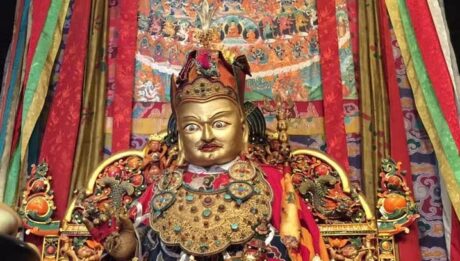
Being Able to See Your Faults Without Losing Your Dignity and Being Patient Without Any Regrets
Read More »Kindness & Compassion
Kindness and compassion are integral qualities on the Buddhist path. We cultivate these qualities, throughout our journey. In the beginning, we may engage in mostly conceptual reflection. But over time, with habituation, we naturally come to embody kindness and compassion. Genuine compassion, Phakchok Rinpoche explains, is compassion free of any aggression. Moreover, that compassion does not have grasping. Authentic compassion is unimpeded and embraces all beings.
Devotion & Pure Perception
In the Dakpo Kagyü tradition, the lineage prayer includes the statement:
Devotion is the head of meditation, as is taught.
The guru opens the gate to the treasury of oral instructions.
To this meditator who continually supplicates him
Grant your blessings so that genuine devotion is born in me.
On the Vajrayāna path, everything connects to guru devotion. When we practice, all our efforts–śamatha meditation, development stage practices, renunciation, bodhicitta, and enhancement methods such as sang practice–rely on the view of guru devotion to make them truly Vajrayāna practices.
Pilgrimage & Sacred Sites
Pilgrimage to sacred sites recurs throughout all Buddhist traditions. Indeed, we read in the early texts of Buddha Shakyamuni’s own pilgrimages to honor the sites of previous Buddha activity. Such stories reveal to us the importance of visiting sacred sites. When we approach the places of practice and activity of great siddhas and bodhisattvas with open hearts and minds, we can receive the blessings of their practice. Pilgrimage is a joyful experience that can aid us in realizing the nature of our minds. Because it is so beneficial, our sister organization, Nekhor, provides invaluable resources to guide our physical or virtual journeys.
The Buddha & Great Masters
It is said that every syllable of the Buddhadharma has the power to liberate us if we understand and apply the meaning in our own experience. For this reason, it is beneficial to regularly study, reflect and practice the instructions given by the Buddha and the great masters and adepts of the past. We can reflect on their supreme kindness is guiding us along the pathway, ensuring that our practice is authentic.


